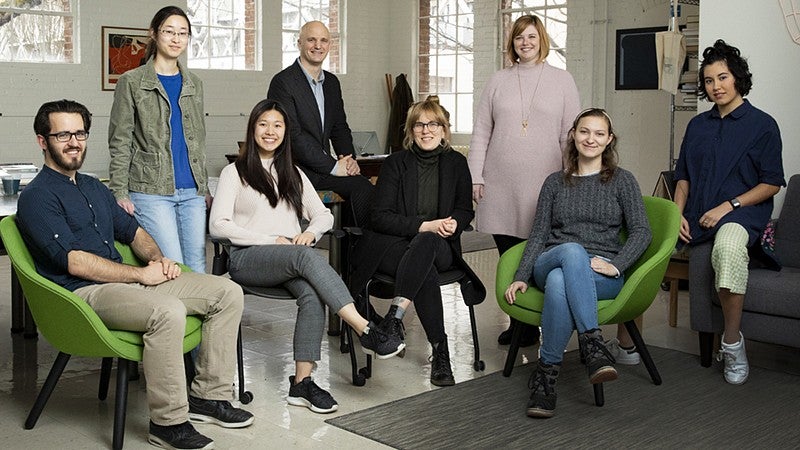
Designing the Future: College of Design Embraces Innovation, Diversity
The College of Design is shaping the future with its research, institutes, and student initiatives
By Alex Cipolle • Photo by Chris Larsen • April 3, 2019
3 min read
The College of Design comprises the School of Architecture & Environment (SAE), the School of Art + Design (A+D), the School of Planning, Public Policy and Management (PPPM), and the Department of the History of Art and Architecture (HAA). The college builds on a 100-plus-year tradition of bringing creative design disciplines together. Until 2017, the college was known as the School of Architecture and Allied Arts.
Walk the halls of the College of Design and it quickly becomes clear that it is an intellectually cosmopolitan space.
On any given day you’ll see students presenting design schemes for zero-emissions housing, building models for a terraced landscape, or testing the impact of a new lighting design. Some are hashing out public policy or drafting a plan for a revitalized downtown. Others can be found prepping a gallery for an art installation, curating a museum exhibition, sketching out designs for a bicycle prototype, or restoring an historic building.
Deliberately eclectic in its areas of expertise, the college is home to scholars, practitioners, and students whose work cuts across creative fields, weaving together aspects of design from the micro (e.g., jewelry-making) to the macro (e.g., environmental policy).
Complementing its disciplinary diversity, the College of Design is firmly committed to equity and inclusion, representing voices and cultures in its educational community to better reflect the diversity of society.
“If you work in creative fields and your job is to innovate, then you absolutely need diversity. We need a mix of ideas, values, perspectives, geographies, histories, languages, and cultures,” says Christoph Lindner, professor and dean.
The college is furthering its commitment to diversity in design through the faculty members it hires, the students it recruits, and the research it supports.
The SAE’s new Design for Spatial Justice fellowship initiative will draw additional faculty members who work at the intersection of race, ethnicity, indigeneity, gender, sexuality, and economic inequality.
“Design for Spatial Justice will build our capacity to take on the hardest, highest-stakes questions in design for environmental and social justice,” says Erin Moore, head of SAE and associate professor of architecture and environmental studies. “The initiative also demonstrates that we are dedicated to building a community of students, designers, and scholars whose excellence is inseparable from their diverse and global perspectives.”
In addition, the College of Design’s inaugural Tinker Hatfield Award for Innovation, which comes with a $25,000 prize, will advance topics in equity and diversity through research. The inaugural winning projects are the Albina African American Cultural Heritage Conservation and Universal Design for Healthy Aging. Additionally PPPM’s Access and Equity Research Group is researching diversity, equity, and inclusion in public processes.
Forward-thinking initiatives also come from the College of Design’s students. The annual HOPES conference, Supporting the Advancement of Diversity in Design (STAnDD), and Kitchen Sync Magazine are some of the ways students are bridging disciplines, connecting people, working inclusively, and making visible the issues they care about.
The College of Design’s research labs and institutes, where undergraduate and graduate students work alongside faculty members and contribute to scholarship, also shape the world through collaboration. The TallWood Design Institute brings together UO architecture and Oregon State University’s colleges of forestry and engineering to develop sustainable mass-timber products. And the new Institute for Health in the Built Environment combines design and architecture with microbiology and health sciences to create healthier indoor spaces.
Whether it’s a work of art displayed in Berlin or a policy paper that influences government funding for sustainable transportation, the College of Design’s influence spans the country and the world.
“Research is vital to all disciplines in the college—just as it’s vital to the university as a whole. We do a lot of experimental and imaginative work, and we complement that with applied research and teaching. What drives our research is our shared commitment to environmental sustainability and to creating a more socially and economically equitable world,” says Lindner.
Dean Christoph Lindner will become dean of the Bartlett Faculty of the Built Environment at University College London, leaving the College of Design in August. The UO has begun an international search for a successor.
Alex Cipolle, MA ’11 (journalism), is the College of Design staff writer.




